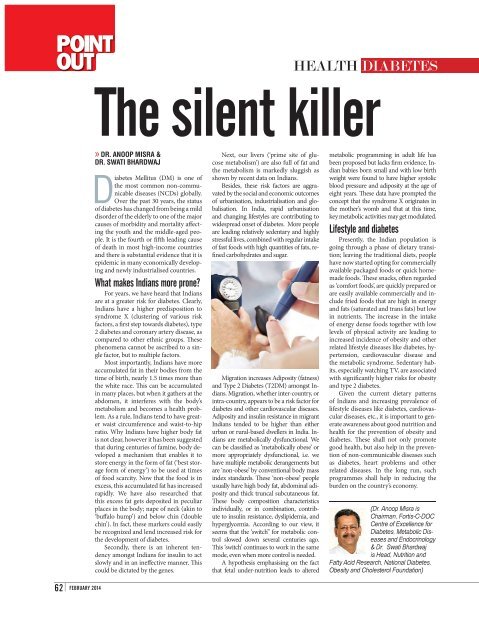POINT OUT February 2014 Edition
POINT OUT Magazine February 2014 Edition
POINT OUT Magazine February 2014 Edition
You also want an ePaper? Increase the reach of your titles
YUMPU automatically turns print PDFs into web optimized ePapers that Google loves.
<strong>POINT</strong><br />
<strong>OUT</strong><br />
HEALTH DIABETES<br />
The silent killer<br />
» DR. ANOOP MISRA &<br />
DR. SWATI BHARDWAJ<br />
Diabetes Mellitus (DM) is one of<br />
the most common non-communicable<br />
diseases (NCDs) globally.<br />
Over the past 30 years, the status<br />
of diabetes has changed from being a mild<br />
disorder of the elderly to one of the major<br />
causes of morbidity and mortality affecting<br />
the youth and the middle-aged people.<br />
It is the fourth or fifth leading cause<br />
of death in most high-income countries<br />
and there is substantial evidence that it is<br />
epidemic in many economically developing<br />
and newly industrialised countries.<br />
What makes Indians more prone?<br />
For years, we have heard that Indians<br />
are at a greater risk for diabetes. Clearly,<br />
Indians have a higher predisposition to<br />
syndrome X (clustering of various risk<br />
factors, a first step towards diabetes), type<br />
2 diabetes and coronary artery disease, as<br />
compared to other ethnic groups. These<br />
phenomena cannot be ascribed to a single<br />
factor, but to multiple factors.<br />
Most importantly, Indians have more<br />
accumulated fat in their bodies from the<br />
time of birth, nearly 1.5 times more than<br />
the white race. This can be accumulated<br />
in many places, but when it gathers at the<br />
abdomen, it interferes with the body’s<br />
metabolism and becomes a health problem.<br />
As a rule, Indians tend to have greater<br />
waist circumference and waist-to-hip<br />
ratio. Why Indians have higher body fat<br />
is not clear, however it has been suggested<br />
that during centuries of famine, body developed<br />
a mechanism that enables it to<br />
store energy in the form of fat (‘best storage<br />
form of energy’) to be used at times<br />
of food scarcity. Now that the food is in<br />
excess, this accumulated fat has increased<br />
rapidly. We have also researched that<br />
this excess fat gets deposited in peculiar<br />
places in the body; nape of neck (akin to<br />
‘buffalo hump’) and below chin (‘double<br />
chin’). In fact, these markers could easily<br />
be recognized and lend increased risk for<br />
the development of diabetes.<br />
Secondly, there is an inherent tendency<br />
amongst Indians for insulin to act<br />
slowly and in an ineffective manner. This<br />
could be dictated by the genes.<br />
Next, our livers (‘prime site of glucose<br />
metabolism’) are also full of fat and<br />
the metabolism is markedly sluggish as<br />
shown by recent data on Indians.<br />
Besides, these risk factors are aggravated<br />
by the social and economic outcomes<br />
of urbanisation, industrialisation and globalisation.<br />
In India, rapid urbanisation<br />
and changing lifestyles are contributing to<br />
widespread onset of diabetes. More people<br />
are leading relatively sedentary and highly<br />
stressful lives, combined with regular intake<br />
of fast foods with high quantities of fats, refined<br />
carbohydrates and sugar.<br />
Migration increases Adiposity (fatness)<br />
and Type 2 Diabetes (T2DM) amongst Indians.<br />
Migration, whether inter-country, or<br />
intra-country, appears to be a risk factor for<br />
diabetes and other cardiovascular diseases.<br />
Adiposity and insulin resistance in migrant<br />
Indians tended to be higher than either<br />
urban or rural-based dwellers in India. Indians<br />
are metabolically dysfunctional. We<br />
can be classified as ‘metabolically obese’ or<br />
more appropriately dysfunctional, i.e. we<br />
have multiple metabolic derangements but<br />
are ‘non-obese’ by conventional body mass<br />
index standards. These ‘non-obese’ people<br />
usually have high body fat, abdominal adiposity<br />
and thick truncal subcutaneous fat.<br />
These body composition characteristics<br />
individually, or in combination, contribute<br />
to insulin resistance, dyslipidemia, and<br />
hyperglycemia. According to our view, it<br />
seems that the ‘switch” for metabolic control<br />
slowed down several centuries ago.<br />
This ‘switch’ continues to work in the same<br />
mode, even when more control is needed.<br />
A hypothesis emphasising on the fact<br />
that fetal under-nutrition leads to altered<br />
metabolic programming in adult life has<br />
been proposed but lacks firm evidence. Indian<br />
babies born small and with low birth<br />
weight were found to have higher systolic<br />
blood pressure and adiposity at the age of<br />
eight years. These data have prompted the<br />
concept that the syndrome X originates in<br />
the mother’s womb and that at this time,<br />
key metabolic activities may get modulated.<br />
Lifestyle and diabetes<br />
Presently, the Indian population is<br />
going through a phase of dietary transition;<br />
leaving the traditional diets, people<br />
have now started opting for commercially<br />
available packaged foods or quick homemade<br />
foods. These snacks, often regarded<br />
as ‘comfort foods’, are quickly prepared or<br />
are easily available commercially and include<br />
fried foods that are high in energy<br />
and fats (saturated and trans fats) but low<br />
in nutrients. The increase in the intake<br />
of energy dense foods together with low<br />
levels of physical activity are leading to<br />
increased incidence of obesity and other<br />
related lifestyle diseases like diabetes, hypertension,<br />
cardiovascular disease and<br />
the metabolic syndrome. Sedentary habits,<br />
especially watching TV, are associated<br />
with significantly higher risks for obesity<br />
and type 2 diabetes.<br />
Given the current dietary patterns<br />
of Indians and increasing prevalence of<br />
lifestyle diseases like diabetes, cardiovascular<br />
diseases, etc., it is important to generate<br />
awareness about good nutrition and<br />
health for the prevention of obesity and<br />
diabetes. These shall not only promote<br />
good health, but also help in the prevention<br />
of non-communicable diseases such<br />
as diabetes, heart problems and other<br />
related diseases. In the long run, such<br />
programmes shall help in reducing the<br />
burden on the country’s economy.<br />
(Dr. Anoop Misra is<br />
Chairman, Fortis-C-DOC<br />
Centre of Excellence for<br />
Diabetes, Metabolic Diseases<br />
and Endocrinology<br />
& Dr. Swati Bhardwaj<br />
is Head, Nutrition and<br />
Fatty Acid Research, National Diabetes,<br />
Obesity and Cholesterol Foundation)<br />
62<br />
FEBRUARY <strong>2014</strong>
















